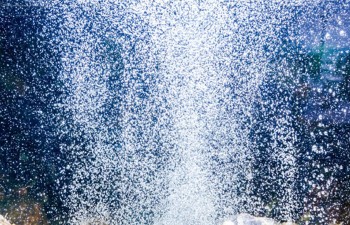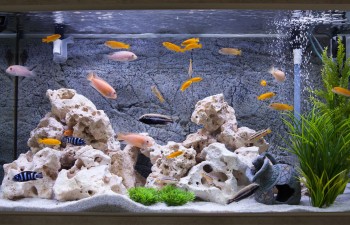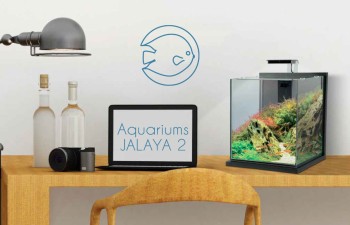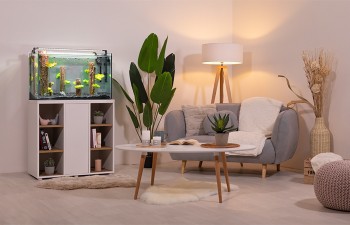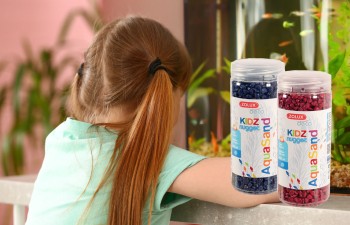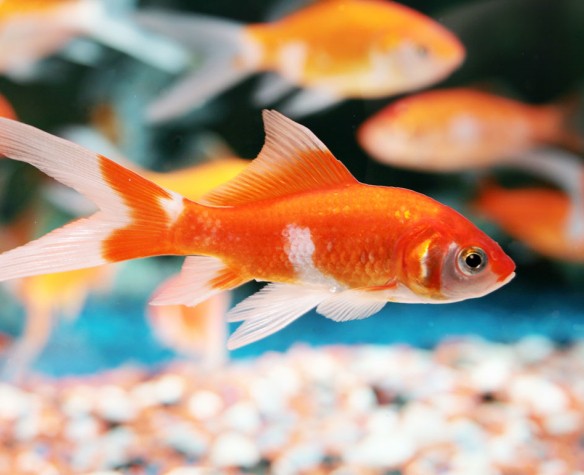
Goldfish habitat
Introduction
A goldfish aquarium (cold, moderated water tank) is usually the first fish tank installed in a household. This « cold water » phase constitutes the first leg in the discovery of this wonderful and exciting hobby that is “Fishkeeping”… With a little care, respect and some basic knowledge our goldfish friends will become the most robust and the easiest to maintain of the ornamental fish species.
The goldfish is not a fragile or difficult species to maintain, nevertheless for a healthy fish, one must follow certain precautions and gather necessary information. Although it can withstand very extended ambient temperatures ( 3° to 28°C at the extreme), the ideal range of water temperature is between 16° and 22°C (average house temperature).
Goldfish are omnivores, greedy and tend not to know when to stop eating. At a mature adult age, it can reach between 15 and 30 cm, depending on: the volume of water, its comfort as well as the quantity and quality of the food that will be provided throughout its life. It is therefore necessary to adapt the living habitat (expansion) during the course of its life.
To enable your goldfish to develop harmoniously, we recommend that you Do not leave it alone in its environment (one or more companions will be essential to its well-being and life balance). Give them enough space and a sufficient volume of water to allow them to grow in a friendly environment that respects their life balance.
Longevity
If it is brought up in optimal conditions, a goldfish’s life expectancy can range from 15 to 20 years.
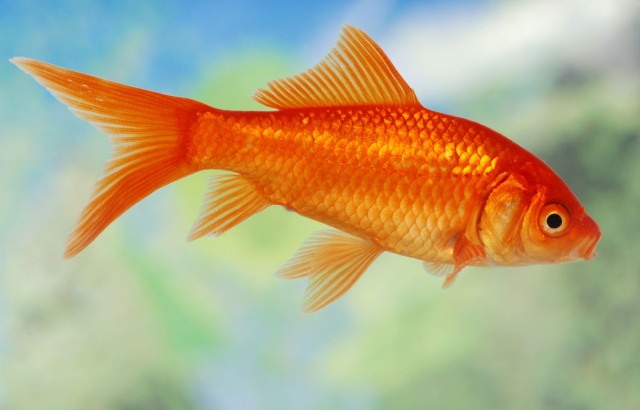
Installing my aquarium
An aquarium will be especially appreciated in a quiet and dimly lit area: reception room, lounge area, office, waiting room … It must avoid direct sunlight or too much brightness (window or bay window) facing southwards (which results in a rise of temperature and the anarchic development of displeasing algae parasites).
Setting up the aquarium
One must place the tank on a very stable, flat and solid enough surface. Warning: once filled with water, a 50 cm aquarium can weigh up to 45kg! (Security info: a thin 3mm layer of polystyrene between the tank and surface will reduce the risk of physical stress, scratching and leaking; available in all DIY stores).
Gently scrub the inside of the tank with a clean sponge, free of all detergent and bleach substances (very toxic to fish!). Be sure to also clean all the accessories used in the aquarium.
A cover (glass or other material) is highly recommended. It insulates the tank, prevents the risk of accidents and external pollution (dust, harmful particles, visit from the cat, etc …) It significantly reduces the amount of evaporated water and also prevents a potential escape!
Installation
The installation of an aquarium can be broken down into the following steps
- Setting up the ornamental base layer
The quality and neutral aspect of the gravel base (decorative liner) are very important factors. Whether using natural, artificial or coloured gravel, choose a neutral sand or gravel (2 to 5mm in diameter) specially selected for fish tanks.
Our tip
Rinse the gravel several times with clean water, place in the bottom of the tank and pat down with the flat of the hand - 3 to 4 cm is an ideal thickness. A slight tilt from the back of the tank to the front will give a better angle of perspective and subsequently ease cleaning.
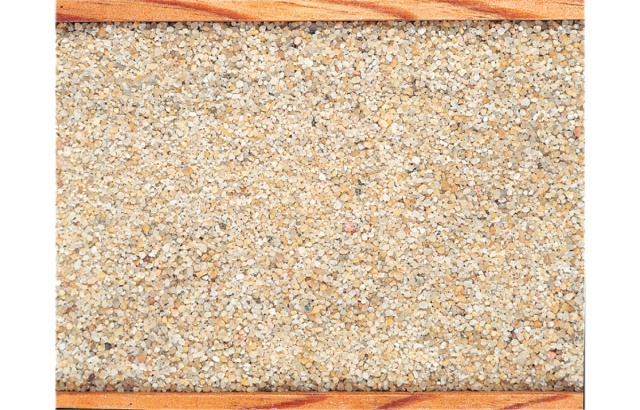
- Filter installation (recommended)
Filter : this is a small, useful device that is inexpensive and very simple to install. It filters and clears any unwanted bacteria in the water while keeping fish happy and healthy.

"NanoLife Flow 200 Max" filter (ref. 328 902)
It also helps avoiding the tedious job of cleaning the inside of the tank on a regular basis.
We can only advise the purchase of such an accessory.
If necessary, rinse the clear-water filtration masses, reposition the filter and place the whole at on the far wall of the aquarium. The nozzle of the filter should be on the same level as the water inside the tank.
Ventilation : Most internal filters are equipped with nozzles with an automatic, ventilation system (Venturi) which form air bubbles inside the tank. This oxygen is necessary for the balance of the aquarium and your fish.
Do not connect immediately to power supply.
-
Positioning decorative objects (rocks, resins, roots, plants, etc…)
Rinse the ornaments with clear water and place carefully in the aquarium (only use clean, neutral, inoffensive objects). Avoid rocks and decorations with sharp or metallic particles (iron, copper …) or “limestone” (simple safety test: a few drops of warm vinegar on the object should not lead to the formation of bubbles!) Where appropriate, these substances would disintegrate more or less rapidly in the water, eventually, saturating, polluting and making the water unfit for aquatic life.
Gently rinse the plants (natural or artificial) and carefully put them in the aquarium. Place the rockeries on the sides and towards the rear of the tank, taking care to leave beautiful, open “beaches” (swimming zones) near the front for the future residents.
Without being imperative, the establishment (even partial) of natural plants and folia is highly recommended. Indeed, aquatic plants always have a beneficial, biological effect on the environment and the fish themselves and are more and more a source of nutrition in an aquarium.
- Filling the aquarium with water
Carefully fill with tap water (place a plastic sheet on the gravel so as not to disturb the décor with the water pressure), leaving a 1cm gap to avoid overflowing.
- Connecting the filter (optional)
Connect the filter and verify any technical problems.
- Water preparation and treatment
Once the aquarium is filled with water it is necessary to neutralize the chlorine and heavy metals (toxic to fish) by adding a dose of water conditioner. And finally to develop a fast and efficient biological balance, it is worth adding a dose of micro-organisms purifier such as Safe Start by Tetra.
- Lighting (optional)
Set up a timer (10h) which allows you to time the lighting period . There must be between 8 and 10 am lighting according to the position in the room.

Settling the fish in
After letting the water stand for 24 hours, you can now start welcoming the first resident to its new home. Then another every 24 hours.
On average, one fish requires 4 litres of water (this average may vary depending on the weight and size of the fish).
Our tip
Be careful when settling your fish in the aquarium. A difference in water quality or a thermal shock (different temperatures) can be very harmful to your fish. Therefore operate in the following manner: place the pouch to soak on the surface of the water so that it slowly acclimatises to the temperature of the tank. After ten minutes, carefully open the top of the pouch and allow a small amount of the tank water to blend with the pouch water; after another ten minutes, let the fish out of the bag.

Necessary equipment and accessories
- Aquarium
- Gravel (special aquarium)
- Filter/ventilation; aeration (advised option)
- Decoration and plants
- Water conditioner and microorganisms balance.
- Various maintenance accessories (net/scoop, scraper and magnet cleaner)
- Feeding (flakes, pellets or freeze-dried prey)
Choosing the aquarium
Ball or aquarium?
It is recommended to associate « ball tanks » and other small « aquarium kits » low in volume, with the creation of « Nano-aquariums » that enable you to recreate a balanced ecosystem for smaller, tropical-water fish and crustacean species such as Danio Rerio, Tanichtys, Betta and Siamese fighting fish, shrimps (Caridina) etc…
The ball does not allow oxygenation of the water and is thus necessary to change it more often than for an aquarium:
- Ball : 1/3 of the water should be changed every week + entirely once a month
- Aquarium (with filtration-lighting) : 1/3 of the water should be replaced every 2 months.

